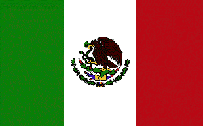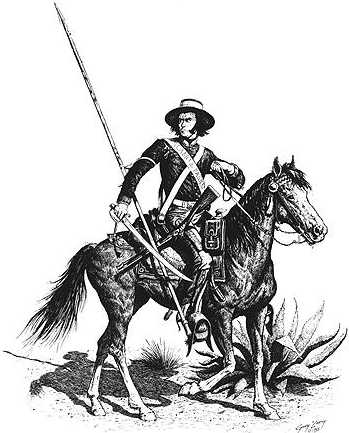|
Text
and illustration courtesy Dr. Stephen L. Hardin |
The Flying Company Stationed in San Antonio de Bexar, the men of the Second Flying Company of Alamo de Parras were accustomed to the rigors of frontier garrison life. The fledgling Republic of Mexico, beset by civil strife and economic uncertainty, was hard pressed to pay, feed, uniform, and equip its soldiers adequately even in the interior. Those serving on the far-flung frontera could expect even less, normally the dregs and hand-me-downs from an inefficient and corrupt supply system.Writing from Nacogdoches in 1828, General Manuel Mier y Teran complained: "The garrison of this fort has received nothing for seven months, and is therefore reduced to the most deplorable state. "For Mexican soldiers in Texas, this "deplorable state" became a way of life, and conditions had not greatly improved by 1835. This illustration reflects a trooper under prolonged neglect. His uniform is patched and threadbare; his mount is far from a thoroughbred; and his deportment is that of one who has been dispatched to the edge of nowhere and forgotten. He has no motive to fight gringo rebels and resents being ordered to risk his life for a cause he does not fully understand. His hat is of the type illustrated by the European lithographer Claudio Linati in 1828; note the wide band that obscures the crown except for about an inch at the top. The dark blue coatee had red collars and cuffs. While on campaign, troopers favored the loose-fitting blue or gray overalls reinforced with leather. A red stripe ran the full length of the outside seam of the pant leg. Boots and spurs are of a civilian pattern and are like those worn by local vaqueros. Indeed, much of his kit reveals heavy borrowing from the Texas ranching culture. The saddle and bridle are probably the handiwork of local craftsmen. On the frontera, one made do with whatever was available--regulation or not.For purposes of illustration, this trooper is well armed, but not all those who served in his unit would have been issued such a wide array of weaponry. The lance is drawn after those illustrated by Linati, and a specimen is currently on display in the Long Barracks Museum at the Alamo. The tercerola (carbine) is a holdover from the Spanish period. Manufactured in 1815, it is actually no older than the Brown Bess muskets used by most Mexican infantrymen. Like Spanish Cuera (leather jacket) Dragoons from which the flying companies evolved, this trooper prefers the espada ancha to the longer regulation sword. The sword depicted here is drawn after one that Texas Ranger Robert Hall captured in Mexico in 1847, but a blade of this type would have been common in Texas a decade earlier. This distinctive weapon is currently housed at the Los Nogales Museum in Seguin, Texas.
|

